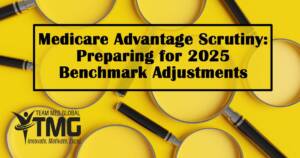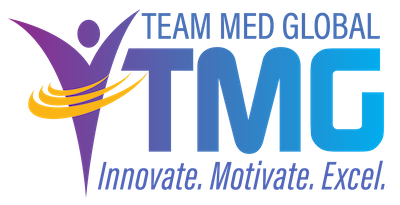 Medicare Advantage (MA) plans continue to grow in popularity, with more beneficiaries enrolling each year. However, as enrollment rises, so does regulatory scrutiny. For Medical Services Professionals (MSPs) tasked with managing practitioner licensing, credentialing, and enrollment, the upcoming 2025 benchmark adjustments bring both challenges and opportunities. Staying ahead of these changes will be critical to ensuring compliance, maintaining network adequacy, and optimizing organizational performance.
Medicare Advantage (MA) plans continue to grow in popularity, with more beneficiaries enrolling each year. However, as enrollment rises, so does regulatory scrutiny. For Medical Services Professionals (MSPs) tasked with managing practitioner licensing, credentialing, and enrollment, the upcoming 2025 benchmark adjustments bring both challenges and opportunities. Staying ahead of these changes will be critical to ensuring compliance, maintaining network adequacy, and optimizing organizational performance.
The Landscape of Medicare Advantage for 2025
Medicare Advantage offers beneficiaries an alternative to traditional Medicare, emphasizing managed care and supplemental benefits. The Centers for Medicare & Medicaid Services (CMS) adjust MA benchmark rates annually to account for factors such as geographic variation, risk coding, and policy changes. For 2025, these adjustments will include:
Greater Oversight on Star Ratings: Star ratings, which influence plan reimbursements and enrollment incentives, will face heightened scrutiny. Plans with low ratings risk penalties, while high-performing plans may see financial rewards.
Focus on Risk Adjustment Accuracy: CMS is increasing its focus on risk coding practices to ensure payments align with patient complexity and care needs.
Continued Emphasis on Value-Based Models: Plans are expected to expand their value-based initiatives, requiring robust networks of credentialed and compliant practitioners.
How Licensing, Credentialing, and Enrollment Drive Success in MA
Maintaining Up-to-Date Licensing: Licensing errors are among the most common causes of compliance violations. Practitioners must meet state licensure requirements and specialty certifications mandated by CMS and MA plans.
Action Steps:
- Conduct regular audits of practitioner licenses to ensure compliance.
- Use automated systems to track license renewals and manage multi-state licensing for telehealth practitioners.
Credentialing for Quality and Compliance: Credentialing verifies that practitioners meet the qualifications necessary to deliver care under MA plans, aligning their competencies with quality metrics and network adequacy standards.
Action Steps:
- Establish workflows to ensure that credentialing aligns with payer-specific requirements.
- Collaborate with quality improvement teams to ensure practitioners support star rating goals.
Streamlining Provider Enrollment: Enrollment links practitioners to payer contracts, ensuring they are recognized for reimbursement and listed in networks. Accurate and timely enrollment is critical to avoid gaps in care and financial penalties.
Action Steps:
- Verify that practitioner enrollment data matches claims submissions and network rosters.
- Expedite enrollment for high-demand specialties to support network adequacy requirements.
Strategies to Navigate 2025 Benchmark Adjustments
Align Credentialing and Enrollment with Star Ratings: CMS evaluates MA plans on metrics tied to practitioner performance, including patient satisfaction, care coordination, and preventive care outcomes.
Action Steps:
- Regularly review credentialing and enrollment processes to ensure alignment with star rating criteria.
- Provide ongoing education to practitioners about their role in achieving quality metrics.
Prepare for Increased Risk Adjustment Scrutiny: Risk adjustment practices will be under greater oversight in 2025. MSPs must ensure that practitioner data is accurate and up-to-date to avoid compliance issues.
Action Steps:
- Conduct internal audits to confirm that practitioner enrollment aligns with claims data.
- Monitor CMS updates on risk adjustment policies and implement necessary changes proactively.
Strengthen Network Adequacy Efforts: Medicare Advantage plans must meet CMS standards for network adequacy, ensuring patients have access to appropriate care within specific geographic areas and specialties.
Action Steps:
- Map practitioner availability to identify and address gaps in coverage.
- Develop a pipeline for credentialing and enrolling practitioners in high-demand specialties.
Leverage Technology for Operational Efficiency: Managing licensing, credentialing, and enrollment simultaneously can be complex. Automated systems can streamline workflows and ensure compliance.
Action Steps:
- Invest in credentialing and enrollment platforms that integrate with compliance tracking tools.
- Use reporting features to identify and resolve bottlenecks in the licensing, credentialing, and enrollment processes
Challenges to Anticipate
Evolving Regulatory Requirements: CMS frequently updates policies, making it essential for MSPs to remain informed and adaptable.
Increased Demand for Specialists: The emphasis on value-based care will drive demand for behavioral health practitioners, chronic disease specialists, and telehealth providers.
Coordination Across Teams: Licensing, credentialing, and enrollment require collaboration with payer relations, finance, and quality improvement teams to ensure alignment with MA requirements.
As Medicare Advantage plans face heightened scrutiny and prepare for 2025 benchmark adjustments, MSPs are essential to managing compliance and ensuring practitioner readiness. By focusing on licensing, credentialing, and enrollment, MSPs can help organizations navigate these changes effectively and maintain competitive, compliant networks.
Success in Medicare Advantage isn’t just about meeting today’s requirements—it’s about anticipating tomorrow’s challenges and adapting proactively.
